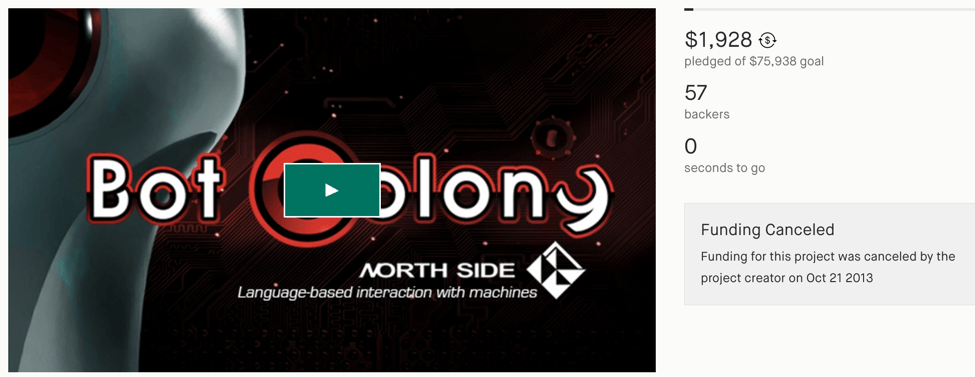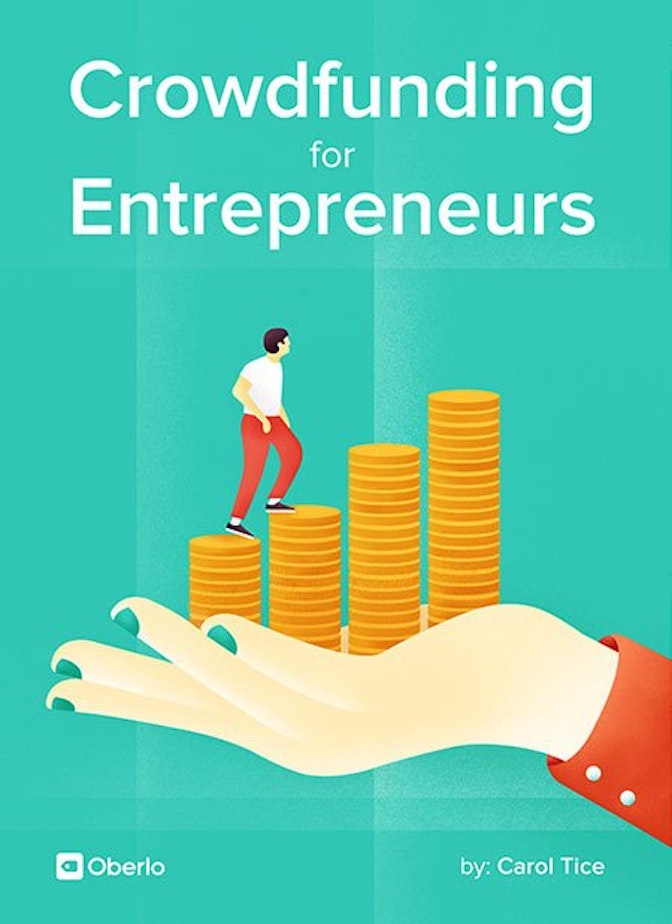Okay—you know how crowdfunding works now and understand how to get startup funding. You’ve compared the top crowdfunding sites and seen that crowdfunding for business is a viable option.
The next task is to assess whether your startup is ready to raise start-up capital right now—and if so, which type of crowdfunding platform is best for you.
Why does it matter so much? Well, crowdfunding for startups is a two-edged sword.
[highlight]When you’re crowdfunding for business, bear in mind that if your funding effort flops, that failure may follow you forever. Remember, we learned in Chapter 2 that just 36% of Kickstarter campaigns succeed.[/highlight]
You don’t want to end up like the makers of the game Bot Colony. They’re still living down their failure to raise nearly $76,000 on Kickstarter, back in 2013.

As you can still see years later, they didn’t even raise $2,000, and had to pull the plug. On a search for “Kickstarter failures,” they pop right up. You don’t want this sort of easily discoverable bad news following your startup around the Internet.
There are no guarantees that using crowdfunding for startup cash will work.
That’s why, in this chapter, you’ll:
- Get do’s and don’ts from the pros
- Learn how to assess your startup’s readiness
- See a case study on online fundraising for business



Crowdfunding For Business: Tips From the Pros
Want to know what really works in crowdfunding for startups? Then you want to talk to experts. I’ve rounded up a diverse group of experienced observers of startup funding online, including an equity-platform founder, crowdfunding investors, and startup entrepreneurs, who share their insights below.
They’ve seen failures as well as successful start-up capital raises. What have they learned? Here are their tips:
→ Click Here to Launch Your Online Business with Shopify

Q: Any pre-launch tips for entrepreneurs?
A: First, have a real understanding of how much work and commitment is required for successful startup funding, even for modest-dollar campaigns. People who are new think, “I can just put it up there and people will care,” or “I’m just going to throw money at it [with ads and hiring marketers], and I won’t have to do anything.”
It’s a daily commitment to creating new content and ideas, and generating momentum, especially very early in the project. Getting a lot of campaign contributions in the first few days is essential.
For my campaigns, we’d be shooting a film, so we’d release early footage, or some music elements. Gets people excited—but requires advance planning.
When I consult, I work with startups to create a campaign that’s going to generate a set of backers that are ready to go, before the campaign even exists. Usually, 20%–30% of the campaign funds from people making verbal commitments, so that day of launch, that money goes right in.
Then, people see momentum, and that it looks like you’re asking for a viable amount. In creative campaigns, the percent of random people who pre-order a product is getting smaller all the time.
One other tip: On Kickstarter (and many other platforms), you can create your campaign page without launching it, and then send it around to people in your network and have them look it over.
Ask them questions—What do you think of the rewards? Is this something you would give to? Get some feedback. Your audience will often give you great ideas.
Q: Any tips on creating enticing rewards for backers?
A: Think about rewards that people would share about in social media. We’ve done funny lip-synch videos with the movie cast that went out to backers.
People like bragging rights, like being able to say they appeared in the credits on a movie. Some people get an IMDB profile from that, which makes them feel special.
Q: Any tips on creating enticing rewards for backers?
A: Think about rewards that people would share about in social media. We’ve done funny lip-synch videos with the movie cast that went out to backers.
People like bragging rights, like being able to say they appeared in the credits on a movie. Some people get an IMDB profile from that, which makes them feel special.

Q: Sherwood, you’ve been involved in equity crowdfunding for startups from the beginning, and were a proponent of opening investing to the masses. Help entrepreneurs understand how investors think and what makes them invest (or not).
A: There are two types of crowdfunding investors—one is your friends, family, and customers. They’ve heard about your product or service.
The other investor is someone on a crowdfunding platform who hears about a deal they have an interest in—they have a shared interest in that industry or problem, or are also engaged in trying to solve that problem.
Q: How can startups attract more investors to their equity crowdfunding campaign?
A: You have to understand what’s in it for the backer. Backers are reputation focused.
They think, first off: Do you have an exit? You have to have exit potential. Nobody’s buying a dry cleaner who’s never going public.
Next, they look at whether you have cash flow. How will you pay back my investment?
Personally, I think more [startup founders] should focus on the crowdfunded loans and revenue-share opportunities. They’re not considered as sexy [as equity deals], but there’s immediate ROI [return on investment].
Q: How important is it to line up key backers ahead of your crowdfunding campaign?
A: I’m not gonna lie to you—if you’re a company looking to raise capital, and you think crowdfunding is how you’re going to do it, and you don’t know any investors, you will fail.
This is not a fishing expedition, where you throw out a net. There’s zero data that proves there’s a networking effect—that if an investor doesn’t know the person raising the money or the solution that’s being addressed, they’ll invest.
You can imagine that if you have a cancer early-detection solution, that people in families affected by cancer would be engaged with it. This could benefit them—they think, “I’m going to invest in this.”
Otherwise, at least 80% of the people who’re going to be funding your campaign will be either first- or second-degree friends, or friends of friends.
Q: You recently did a survey on crowdfunding for startups, surveying over 80 companies that did successful campaigns. What did you learn?
A: Lots of people talked about the marketing and underestimating the time it would take. Some outsourced the marketing, but found no marketing firm has the passion for it that you do.
On average, they spent $12,800 and raised $319,000. For raising less than $100,000, use the embedded legal services that come with the platform. Over that, hire your own.
Q: Did the startup founders talk about outside advertising?
A: Yes. I didn’t realize so many people were paying for Facebook ads—and everyone said they did nothing.
Q: You’re a backer of startups yourself. What startup funding campaigns have you invested in, and why?
A: I’m in 14 platforms, and a shareholder in StartEngine, WeFunder, and others. I’ve also made seven independent investments.
For three of them, I followed the crowd. I’m watching the amount of money pour into a campaign over a few days. It’s clearly going to hit its target fast. I want to get in and see what’s happening. There’s hype around success.
I look at team bios. I look at the pitch video, at how much time you spent putting the script together. Did you address how big the market is? Why do you think your numbers are achievable?
There was a blockchain one—I have cryptocurrencies. So, I could put all my cryptocurrencies into one wallet? I need that solution, so I’ll invest in it.

Q: Talk about your crowdfunding experience. You started small, right?
A: I was in a book-publishing startup, and we raised $300 to do print-on-demand. Raising money wasn’t the main focus—just getting the word out that we existed. We barely made our goal.
Then, I moved into designing board games. Launched a game called Viticulture in 2012—we raised almost $66,000, on a $25,000 goal. Went well, considering only some of the game art was done! Art’s important.
I spent the first two days sending emails to everyone I knew, trying to give them a reason to check out the page. Doing a lot of customized, person-to-person marketing really helped—something I still recommend for newbies.
I’d say, “I made this funny video, check it out,” not necessarily asking them to pledge. Then, I was thanking people who pledged, usually within about an hour. That’s something I look for today, as a backer—it’s a mistake if the creator isn’t communicating with backers.
We raised $1.8 million in 2015 for our game Scythe. It went so big because trust is important, and by then, we’d built up that trust with backers. They look at past track record.
Q: Any tips on building that trust as a newbie?
A: The presentation on the project page can help. Also, if you have information about how you’re going to make and ship your product, show it on your page.
Crowdfunding is more effective if you’ve created your product, and you just need to know how many to make. We spent months of work and expenses leading up to the crowdfunding, so I could hit Print and go when it funded.
In board games, sending out early review copies is big. We got some unbiased, third-party reviewers who would share their thoughts, and those reviews helped backers decide.
Q: What crowdfunding trends do you see emerging?
A: External advertising on places like Facebook and Instagram is becoming more important, and doing sponsored posts. Be an active member in those communities, don’t just show up and ask for something.
Q: Right. It’s not, “Hi, total stranger—would you do me a favor?”
A: [Laughs] Exactly.
Q: What’s your feeling on campaign videos—is short or long better?
A: My technique is to try to make them just 60–90 seconds. That way, people watch all the way through. It conveyed my passion, and is something visual to make people want the thing.
Q: What top mistakes do you see from newbies to business crowdfunding?
A: One big one is creators don’t budget properly, and guess at their costs. That can fail in terrible ways and can ruin your career.
Also, don’t try to please everyone. People will pop up and say, “Could you make this in metal instead?” Respond and share that you love their interest and passion, but if you take every request, it will bankrupt you.
Q: You have one Kickstarter feature you love—please describe.
A: Kickstarter now allows you to follow other people on the platform. I have 5,000 or so followers right now. So whenever I back something, they all get an email that says, “Jamey backed this project.” That’s a really powerful thing, to get a message that a person you trust is backing something.
As a backer, I get those emails, and click, and go back those campaigns.

Q: What do you look for in equity crowdfunding for startups when you review applications on Microventures?
A: We look for companies that are easily explainable online. Can they capture investors’ interest quickly? We look for some kind of traction—could be revenue, partnerships, beta users, churn rates for an app, how often someone uses it, something like that.
We also look for unique ideas —it’s not another knockoff of Groupon, or another drone.
Q: Does the management team need previous successful startup experience? If they’re green, what other assets do they need to get your attention?
A: We care about the team, but a lot of these are first-time founders. If you’re looking for seed investors, we’re not usually the first money in. They’ve all raised money before, in some aspect.
Q: What are the fringe benefits of equity crowdfunding for startups?
A: If you have a consumer product like Sweat Cosmetics (see the Crowdfunding Examples chapter below), you get thousands of new product testers. Those people become your brand ambassadors.
I’ve also seen retail companies get interest in franchising their business. Plant Power [a fast-food startup that raised $450,000 on Microventures] told us they got five to six inquiries from people who said, “I want to franchise this in my state.”

Nathan Rose, investment banker and author of Equity Crowdfunding: The Complete Guide for Startups and Growing Companies (Stonepine Publishing 2016). Rose also created a tool to assess your readiness for equity crowdfunding.
Q: Nathan, what are the common mistakes you see with equity crowdfunding for startups? Are there must-haves – do you need a physical product, for instance? Previous company founder experience?
A: Must-haves: Traction! You can’t be just at the idea stage. It’s not necessary to have a physical product, or previous founder experience, but it certainly helps.
If you don’t have a physical product, can you point to patents, or testimonials? The more progress you can show towards customers, revenue, and profit, the better.
Q: What’s a top mistake you see in crowdfunding for startups, when companies first try equity crowdfunding?
A: Common mistake: Don’t try to do everything digitally. Many startup founders try to do everything through online marketing—content marketing, social media, etc.
Get out from behind the computer screen, show up to real events, and meet people in person—particularly, large investors who may be capable of writing larger checks.
Q: What type of company story appeals to equity crowdfunding investors – what are they looking for?
A: They’re looking for campaigns other investors have backed. “Crowd” investors are looking for the social proof of what the smart investors are doing, so they can follow in their footsteps.
Q: How do you create buzz with the investor types who matter for equity crowdfunding?
A: Start by getting large investors on board. These are the ones who will generate the best social proof and get the initial traction for your campaign. Then, think carefully about who the ideal investor is for your company—as in, their age, demographic.
Put your campaign in places where they hang out. For instance, if you have a pet food startup and want to do equity crowdfunding, ask: “Where do pet owners go, and how can I get my offer in front of them?”
Q: Top tips for success raising start-up capital?
A: Begin with your crowd-building far in advance of actually needing the money. A highly engaged crowd needs to be cultivated over time. And you have the responsibility to provide value to them and help them get to know you, long before you ask them to invest.
Is YOUR Startup Ready For Online Fundraising? A Quiz
Now that you’ve heard the pros dish about crowdfunding for startups, let’s boil that down into a few key questions to ask yourself, to see if your moment to raise start-up capital has arrived:
Q: Does our team have time for this now?
Online fundraising of any type is a significant time investment. Someone at your startup will have to devote a big chunk of time to planning, marketing, and then executing your campaign. Is someone available?
Q: Are we at the right stage?
As you’ve seen, crowdfunding your startup’s initial launch—when you don’t yet have a product or service on the market—is very difficult. Consider whether you’d have better odds once you’re more established.
Q: Can we wait to get the money?
It’s often 6 months or longer from idea to funding in equity- or rewards-based crowdfunding for startups. Think on whether your financial needs are more pressing than that time frame can accommodate. If so, you probably need to look at crowdlending—or at other funding options.
Q: Does my startup have the budget for online fundraising?
You know the saying: It takes money to make money. Be sure you have a marketing budget before you embark.
Q: What is our marketing plan?
Online fundraising for startups rarely succeeds without heavy marketing. Know who will create videos, contact media, hit social media, and email your list.
Q: Is our team seasoned?
It’s easier to raise money online if your team has major credibility in your industry, from past jobs or other startups. A green team faces an uphill battle.
Q: Is what we offer unique?
Groundbreaking solutions and products tend to readily attract backers in crowdfunding for startups, not copycats. Think about whether you can position your offering as something truly new in the marketplace.
Q: Do we know costs and timelines for making our product?
If your rewards-based campaign involves product delivery, it’s critical to know your cost and delivery timeframe, so you can avoid angry backers (or taking a loss on your product). Guesstimating can be disastrous, as you’ll see in the Crowdfunding Examples chapter below.
Q: Do we have connections?
If you can get key investors or top industry influencers on board before you launch your campaign, crowdfunding a startup business is easier.
Q: Are early backers ready to go?
Remember, pledges in a campaign’s first few days are critical in online fundraising.
Q: Can we get media coverage?
Many crowdfunding campaigns get put over the top by favorable media coverage. Have you had any in the past? If not, think about whether you could get any media help in generating buzz. It’ll be a tougher slog without it.



Crowdfunding, Crowdinvesting, Crowdlending: Which Is For You?
If that Q&A above led to the insight that you’re ready to get your startup some crowdfunding money, the next step is deciding what type of platform to use.
Where do you fit into the crowdfunding world? Here’s a quick summary of the key success traits for each crowdfunding type:
Rewards-Based Crowdfunding
Key traits of successful, rewards-based crowdfunding for business startups include:
- A pre-built audience or network of customers, friends, or social media followers
- A product or project that’s new, innovative, and unusual
- The ability to get media coverage
- Available time to promote the campaign
Equity Crowdfunding a/k/a Crowdinvesting
Key traits that help companies raise startup capital through equity crowdfunding include:
- Willingness to give up an ownership stake
- Management team with a proven track record at past startups, or job history at major industry companies (i.e., Google, Apple)
- Past history of successful fundraising
- Contacts in the investor community
- Technology angle is a big plus
Peer-to-Peer Crowdfunding a/k/a Crowdlending
Key traits that help startups succeed in P2P crowdfunding:
- A good credit rating
- In business usually at least 6 months to 1 year
- The ability to tell a compelling story about why your startup needs money
To sum up: If your small business is off the ground—or has the cred to attract attention online—crowdfunding for startups can be a great way to grow. Choose the type of crowdfunding for business that’s right for your company.


